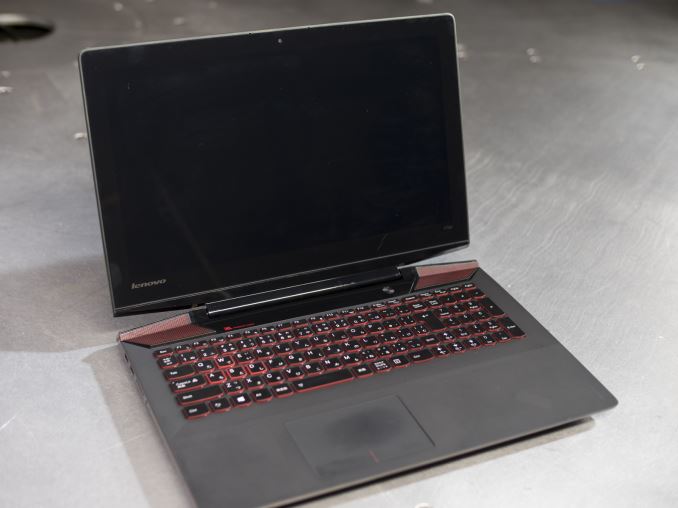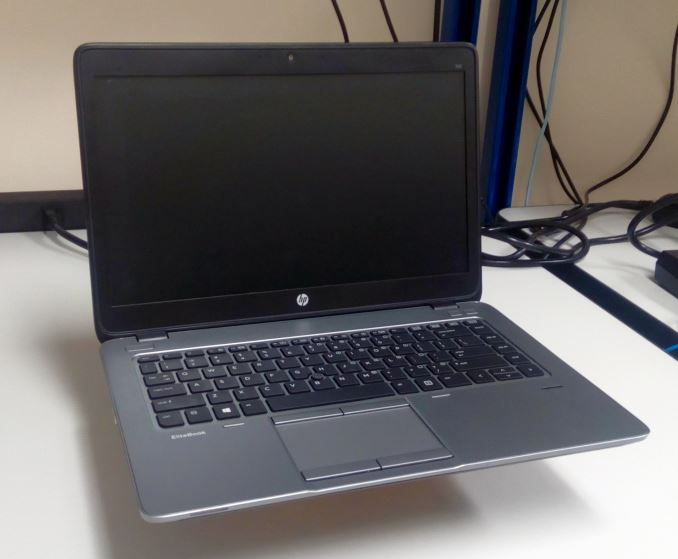Who Controls the User Experience? AMD’s Carrizo Thoroughly Tested
by Ian Cutress on February 4, 2016 8:00 AM EST
In Q2 of 2015, AMD officially launched Carrizo, their new APU aimed at mobile devices such as laptops and portable all-in-ones that normally accommodate 15W-35W processors. Quoted in the media as 'the biggest change to Bulldozer since Bulldozer itself', the marketing arm of AMD released information regarding the Excavator architecture of the new processor, and which contained a long list of fluid and dynamic implementations on improving the Bulldozer based architecture over the previous iteration of Steamroller (Kaveri). Despite this, AMDs target market for the Carrizo platform has not been receptive to AMDs product stack in recent generations due to issues surrounding performance, battery life and designs. AMD believes to have solved the first two of those matters with Carrizo, whereas the third is out of their hands and up to the OEMs to embrace AMDs platform. We wondered if the OEM’s concerns were well placed, and organized some special testing to confirm AMD’s claims about Carrizo.
Who Controls the User Experience: AMD’s Carrizo Tested
Back in early 2015, we performed a long analysis on Intel’s Core M platform, featuring 4.5W processors under the Broadwell microarchitecture. The purpose of that piece was to test several designs using that line of processors, and examining how the design of the chassis and features of the platform directly affected both performance and user experience. For Brett and I at the time, it was an eye opening endeavor, showing just how the slowest processor in a stack in the right notebook chassis can outperform the fastest, most expensive processor in a bad chassis that is wholly un-optimized.
This review is along similar lines, but instead we are testing AMD’s latest Carrizo platform, which is focused on 15W mobile parts in the $400 to $700 market. We approached AMD after the Carrizo Tech Day back in May with a proposal – to speak to engineers and to test the claims made about the platform. Typically sourcing AMD laptops, at least over the past few years, has been a veritable minefield as they are seemingly never promoted by OEM partners as review samples, or as one senior member put it, ‘Some sales people only seem to offer AMD devices if people specifically ask for them’. Our proposal involved sourcing a number of Carrizo laptops when they were launched and tackling them head on, to see how many of the claims made on the Tech Day were testable but also noticeable and true. The issue AMD and OEMs have is that everyone in the AMD-to-OEM-to-retailer chain is invested in selling the platform, so there needs to be a source of third-party testing for people who don’t trust that chain.
Over the course of a few months, our proposal changed and merged with ideas to speak with AMD’s VPs and engineers, with a number of meetings and discussions. It emerged the best way to do this was to fly to AMD’s HQ in Austin, Texas for a week and get hands on time in the labs. We agreed, as speaking to engineers and learning what is going on behind the scenes at AMD is always a good thing, but on the condition that we were free to setup, test and report without any predisposition to the results. There is an added benefit of having engineers only a floor or two away if a problem was to arise. There have been similar events in the past where media have been invited on-site for canned testing, but we made sure this wasn’t going to be the case before we arrived. For example, Qualcomm has invited select media to in-hand, temporary Snapdragon testing on a couple of occasions, with media free to test and report whatever results.
The Testing
We had four Carrizo devices on hand to test for a week, along with a single Kaveri system. These devices were sourced by AMD, and I put in requests for a variety of price points, hardware configurations and styles, along with some specific testing equipment to which we don’t have access. While it wasn’t possible to get everything on hand due to timing issues, the arrangement at least captured a number of areas we planned on testing.
The testing aimed to cover the devices as units, the underlying hardware, as well as the Tech Day claims. Some of this piece will read like a regular review, some of it similar to our Core M testing regarding performance, power and temperature, but a large part is reserved for discussing both the results and the market. When building a platform like Carrizo, a lot of binary decisions are made that can be good or bad for the processor manufacturer, the OEM or the user. We discuss these in detail as a result of our findings.












175 Comments
View All Comments
Gadgety - Sunday, February 7, 2016 - link
So AMD's marketing and distribution strategy is a failure. The way it's described it would seem consumers specifying their own PCs would be a away around the dominant logic determined by the existing channels. With today's production technology tailor made products on demand should be possible.The other thing I don't get, is why doesn't AMD release a desktop Carrizo 4K capable APU for the FM2+ platform? Do they want to help the motherboard manufacturers sell more motherboards once the new AM4 socket APU:s are out in 2017, or do they want to sell their own existing products?
JMC2000 - Sunday, February 7, 2016 - link
I think it's more along the lines of having an installed base of AM4 boards before any Zen-based APUs roll out.It is possible that if the Athlon X4 845 sells well, AMD could release a full Carrizo part on FM2+.
AlB80 - Sunday, February 7, 2016 - link
What is discrete graphic chip in Lenovo?512sp GCN1.2.... I suspect that this combination is unreal.
Jamesiii - Sunday, February 7, 2016 - link
I have actually ordered Dell's AMD A8-8600P. It is intended as a media machine with the selling points being the low power equating to quiet and the 4K capability. The one thing I did notice is that he does have the Single Channel DDR3L 1600MHz memory. There is no indication on if it unlocks the watts to 35, but I have my doubts given the choice of RAM.I will know more when I get it on Thursday and will update if anyone is still view this thread. But, at $380.00 it is not a bad choice for a media machine.
tygrus - Sunday, February 7, 2016 - link
OBM (the brands) bid for designs by the ODM's based on the design cost and the expected volume. I high cost Intel design can be made profitable by the expectation of very high volumes. Even the most popular AMD design is expected to sell fewer than a low-volume Intel design. Business limitations and commercial forces bias the system towards Intel. Intel also have deeper pockets to sponsor/partner/subsidise designs to make them Intel exclusive. From manufactures to distributors to retail, Intel penalise (withdraw discounts/subsidies) anyone who lets AMD gain market share (many limited to <10%) and limit the use of the "best" designs for AMD (forced to sell only A4 & A6 instead of A8 or better, limit battery and other features so Intel always looks better). The "Intel brakes" applied to AMD limits their opportunities and potential earnings. This has limited the AMD R&D spending and forced AMD to stay behind in some aspects. It's amazing what AMD has done with 28nm but think of the advantage they could have had with 22nm and 14nm if successful achieved much earlier (no more than 9months after Intel).every1hasaids - Monday, February 8, 2016 - link
I owned (owned being the operative word there) a Y700 with the AMD Carrizo FX8800P and can attest to the fact that the cooling solution and probably several other pieces of that device reviewed in this article are not the same design as what is available on the market in the US. There is a known issue of Lenovo skimping on the VRMs on the AMD Y700 which results in heavy throttling taking place. I couldn't play any game for more than 15 minutes before heavy throttling would occur. The data gathered from the review sample in this article should not be associated with the available product on the market. There appears to also be an FX-8700P variant of the Y700 out there however I cannot find any documentation of the existence of this device on Lenovo's site. Needless to say that I returned that laptop due to the significant throttling problems. I wish this site of some other site could get their hands on one of the FX-8800P Y700 laptops available in the US and put it through testing to reveal the problems with the unit. I'm guessing that they intend on releasing a Carrizo-L version of that laptop with the same motherboard which is why the VRMs are not up to the task of the 35w Carrizo and the added consumption of the dedicated graphics chip.Why are there no units out there that can handle the 35w TDP Carrizo and a dedicated graphics card!?!?!?! It would be a great alternative to the Intel/Nvidia gaming notebook monopoly.
I'm hoping Zen/Polaris will actually see some adoption from OEMs and maybe AMD could even get involved in assisting proper implementation of their products so that the negative stigma could get nullified.
Jamesiii - Monday, February 8, 2016 - link
The FX-8700P would more properly be called an A10-8700P. It sounds like a bit of marketing if they are using the FX handle.On gaming sites people are suggesting you turn off AMD's Turbo Core when gaming to avoid the FPS jumping up and down and overclock the processors. Overclocking a laptop is dicey at best though.
Malih - Monday, February 8, 2016 - link
maybe Microsoft should start making an AMD Surface laptop if they want good competition to drive PC SalesMarcelo Viana - Monday, February 8, 2016 - link
I just don't understand why in a comparison carrizo vs intel you didn't take out the intel chips memory in order to both have 1 channel memory, so do a benchmark for us in a same condition.The entire article show that intel offering has OEMs given what intel chips need, so the point in comparing carrizo vs intel is the chip itself not platform, since AMD has no platform at all.
Elensar286 - Monday, February 8, 2016 - link
That's a large focus of this article, though. The whole point was an investigation in to the implementation of Carrizo APUs by the OEM. It's highlighting exactly how like you said, the OEM platform, is hindering the potential of Carrizo processors.